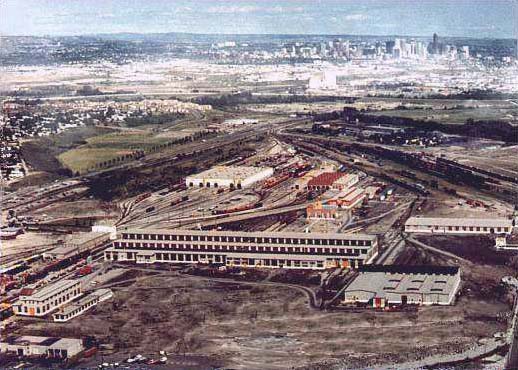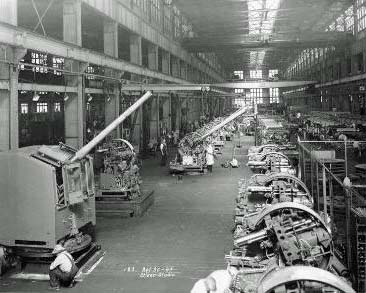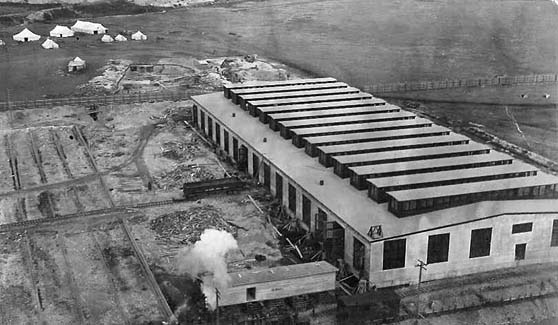
10 January 2011
History of Ogden Shops
By Bill Benner

Aerial view of Ogden Shops - Date/photographer unknown.
|

Calgary Alberta - Next time you enter the Ogden Shop gates, are you aware that you are entering
a significant piece of Calgary and Canadian History?
Construction of Ogden Shops was started in May of 1911 and for the next 11 months, as many as 500 people swarmed all over the work site. In
March of 1912 the Ogden shops were officially opened.
The staff at that time peaked at 1,400 employees. During the Great Depression the staff dwindled down to 600 employees, who worked only 10 days a
month. Ogden Shops was a big employer of many newly arrived immigrants.
The approach of the Second World War brought renewed activity at Ogden Shops. The need for locomotives and cars soon restored staff and production
to their former heights. However, the need for armaments was even greater and in 1941 the shops were re-fitted to make 3 inch Naval guns for the
war effort. By the time peace was restored Ogden shops had turned out 30 million dollars of war armament. Some of these guns can be viewed at the
military museum in Calgary.

This April 1945 photograph of the Canadian Pacific Railway's Ogden Shops in Calgary,
Alberta, shows 4-inch naval guns and their mountings. The Ogden Shops produced two types of 4-inch naval gun mounts, which were installed
on warships, while the gun barrels themselves were produced elsewhere in Canada. The shops produced naval guns for Canadian, British, and
American ships, manufacturing more than 3,000 naval guns and 1,650 naval gun mounts. The 4-inch gun was the largest artillery piece
produced in Canada during the Second World War - George Metcalf Archival Collection.
|
The early site was made up of many shops. The largest was the locomotive shop with 26,000 square feet
(21,000 square meters). Many satellite shops were added such as the wheel shop, air brake shop, car shop, paint shop, carpentry shop, foundry, and
others.
So next time you pass by remember you are looking at almost 100 years of history.

This picture shows No. 2 Coach Shop when it was under construction, to the east outside the
fence surrounding the shops you can see tents were the construction workers lived. It looks like there is a gate where the workers could
access the construction site of the structure. The shop has 15 bays to work on CPR's fleet of passenger coaches. The structure with the
smoke coming out of its chimney is a temporary structure that was probably used by the construction engineers and draftsmen. To the east
of this building and past the railway gondola to the end of shop, a transfer table was built. Coaches entering the shop came onto the
table on the center track where the gondola is sitting, and from there the transfer table traveled on rails to any doorway, and the coach
would be moved in to the shop for its overhaul. The coaches would be stripped of paint, seats would be removed for re-upholstering, and
any other repairs would be done to the running gear and air brakes. The coaches would be re-painted, re-furbished, and moved out of the
shop on the transfer table to return to service. At the time I worked at Ogden, the passenger era was in its twilight, many passenger
trains were abolished, for lack of business. The automobile and airlines had taken their toll on these trains, and many jobs were lost -
Date unknown Larry Buchan.
|

|